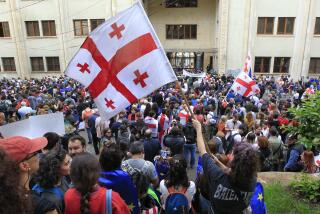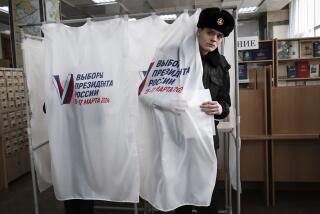Gorbachev Hopes to Parley Referendum on Renewed Federation Into More Power : Soviet Union: The President wants a mandate so he can break his deadlock with Yeltsin, the standard-bearer of economic reform.
- Share via
WASHINGTON — Amid mounting tension and political turmoil, Soviet citizens go to the polls today for the first referendum in their history. Asked to vote for a “renewed federation” of “Soviet socialist republics,” it is widely believed that the fate of the union is not the only future in question. With Mikhail S. Gorbachev and Boris N. Yeltsin locked in an escalating power struggle, there can be no doubt that a showdown is close at hand.
Gorbachev, with less than 10% support in the country, has chosen to go to the nation with an apple-pie-and-motherhood question that he hopes will yield victory--and an excuse to claim legitimacy for his beleaguered presidency.
But his desire to strengthen his hand has nothing to do with pushing reform. Instead, Gorbachev is now protecting the interests of the Communist Party and the central apparatus. Gorbachev wants this mandate so he can break his deadlock with Yeltsin, president of the Russian Federation and current standard-bearer of democratic and economic reform.
How is it that the man who gave us perestroika is now engaged in a life or death struggle with a progressive reformer? The answer lies in the developments of the last six months.
The rift between Gorbachev and Yeltsin became irreparable last October, when Gorbachev accepted and then rejected the radical economic plan, known as “500 Days” or the Shatalin plan. Promoted by Yeltsin and a few of Gorbachev’s liberal economic advisers, the plan called for massive privatization and a methodical move toward a market economy. It also detailed a significant devolution of power from the center to the republics.
As soon as the details were made public, the traditional guardians of Soviet power--the Communist Party, the central bureaucratic apparatus, the KGB and the military--realized decentralization would challenge their authority and drastically reduce their budgets. Gorbachev also understood trouble lay ahead if his “constituents”--the Establishment--lost any more power.
Though the plan was rejected within a month, devolution of power proceeded anyway--anxious republics began to devise ways to save their own economies. Primarily, they sought to cut and reallocate expenditures and create incentives to stimulate work forces.
By the end of November, many republic leaders openly questioned their contributions to the central government budget, advocating a dramatic overhauling of central-government spending. That’s when the Establishment let out its silent scream: “We have a state of emergency! The Soviet Union is threatened!”
In retaliation, the central government began to agitate within the 15 republics for support among the smaller, ethnically autonomous regions or minorities. They also launched a campaign to discredit Yeltsin and other “democrats.” Their relentless propaganda labeled the democrats as “capitalists,” “separatists,” even “traitors.” With dire warnings about civil war and the dissolution of the Soviet Union, these forces hoped to create public support for a firm hand and the reinstitution of a strong central authority.
In fact, the Establishment’s allegations that democrats and republican leaders favor the dissolution of the union is disinformation. Yeltsin and his aides have said repeatedly that they favor “sovereignty” within the framework of a “single renewed union.”
However, Yeltsin, has had fundamental problems with the way Gorbachev has pushed his Union Treaty. He insisted it is not coming from popular action, but “from top downwards.”
Yeltsin’s concept has been to conclude treaties of economic ties and cooperation among the republics, negotiated and implemented among the signatories themselves. To date, there is an impressive network of interrepublic agreements. Russia alone has already concluded treaties with the Ukraine, Byelorussia, Kazakhstan, Estonia and Latvia.
Yeltsin’s “union,” based on strong economic ties and mutual interest, is what economist Stanislav S. Shatalin calls “an equitable partnership rather than an administrative diktat.”
A similar framework is unacceptable for the center. This European Economic Community-style structure would give the republics power over their vast natural resources, as well as their economies and social policies. This autonomy is not only contrary to the country’s imperial tradition, it runs counter to the socialist principles established in the last 74 years.
To stem the tide of this movement for decentralized authority, the central government has used Yeltsin’s arguments to persuade local nationalist groups and party organizations in small ethnic or autonomous regions to declare sovereignty from their popularly elected republican governments and announce their loyalty to the center. In exchange, these “autonomous regions” have been given “republic” status--and an equal place at the Federation Council table.
This restructuring was approved by the USSR Congress of People’s Deputies, to the dismay of the republican governments. It blind-sided, for example, efforts to finalize a treaty between the Russian republic and her autonomous regions.
Such blatant efforts to undermine the power of republican governments have been a undeniable factor in fueling some of the ethnic and regional tension evident today. These “secessionist” drives within the boundaries of existing republics threaten civil war in some regions.
Last week, the Gorbachev-Yeltsin power struggle reached a new pitch. Hoping to increase support in the plebiscite, Gorbachev’s government unveiled their version of his draft Union Treaty before Yeltsin and other republican leaders had the opportunity to agree on the document’s substance.
Amid great fanfare, the document was declared an overwhelming success, because “it was signed by plenipotentiary representatives of 27 republics.” The fact that only eight out of the original 15 “union” republics were even part of negotiation was much underplayed.
The precipitous release of this document sought to pre-empt a number of unresolved conflicts. In this draft, for example, the central government would maintain control over economic issues. This is unacceptable to Russia--and many other republics--because they have already adopted elements of radical economic reform, including “sale of land.” Under central government control, this would never be permitted--as long as communist ideologues dominate the central apparatus.
Democrats are concerned that Gorbachev will use a “yes” on the referendum as an affirmation of “Socialism” because the word “Socialist” appears in the question. To challenge this, Yeltsin’s only hope is that the voters of Russia will also say “yes” to another question placed on the Russian republic ballot: “Do you consider it necessary to create a post of the Russian president to be elected by popular vote?”
If the response is affirmative, Yeltsin will try to become the first directly elected political leader in the history of Russia. Then his legitimacy would increase his power to implement his concept of the union--with Russia as a cohesive political unit at the forefront of radical economic reform.
Traditional Soviet power, however, is not likely to let the situation go that far. Probably, they will either escalate their efforts to discredit Yeltsin and seek his ouster, or choose one of the many brewing crises as their rationale for declaring “presidential rule” or martial law.
This could happen at any time. Imminent consumer price increases of 60% to 120% are likely to create more civil protest and industrial action. Last week, 500,000 people demonstrated near Red Square, calling for Gorbachev’s resignation and a resumption of reform. The coal miners also went out on strike, calling not only for Gorbachev’s resignation but for nationalization of Communist Party property and support for Russia’s sovereignty.
If such threats increase, they could be met by the complete reassertion of control by the Communist Party and by the traditionalists in the army and KGB. In the post-referendum period, the Soviet Establishment might not be as concerned about internal protest or Western public opinion as they were after the Baltics crackdown.
In this environment it is not surprising that Yeltsin went on the attack against central power. Like the final scene in “Butch Cassidy and the Sundance Kid,” Yeltsin, out-numbered and fatally surrounded, came out into the open with all guns blazing.
It only remains to be seen how and when powerful Soviet forces will “take aim and fire”--and when they do, who will be the “casualties.”
More to Read
Sign up for Essential California
The most important California stories and recommendations in your inbox every morning.
You may occasionally receive promotional content from the Los Angeles Times.













